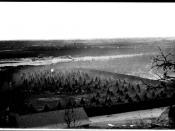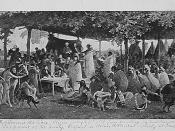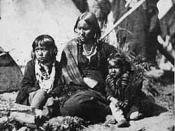The Dakota Conflict is a very big part of Minnesota's history. The white settlers were very unfair with the Dakota people and abused their power. There were many causes of the Dakota Conflict. Some of the things the white people did that caused the Dakotas to rise up and fight with the settlers were the greediness of the white people, the tardiness of the annuity payments, and the way they were unfairly treated by the traders.
The causes of the Dakota Conflict can be broken into long-term and short-term causes. One of the long-term causes was the unfairness of the fur traders. The traders would up the prices, and they kept records that may not have been correct. They made it so the Indians would go way into debt. To pay back the debt, the Indians would give up land and the money they received from the government.
Another long-term cause was the tardiness of the annuity payments.
When the Indians signed the treaties, they were to be paid at the same time every year. The government was late with these payments consistently. The Indians needed the money to buy food and goods from the traders. The Indians were starving and they didn't have any food and there wasn't the wildlife around to hunt. Indians were dying because of the late payments.
One of the short-term causes was the result of the treaty signing at Traverse des Sioux. The Indians gave up twenty-four million acres. They were promised reservations, assistance for schools, payments in gold, and a large sum of money to move their villages. The Indians never got their hands on the money and immediately after the treaty was signed, settlers were moving in to take over the land. Then, the senate decided that the Indians could move further west and they got a treaty signed that said the Indians only had five years to stay on their reservations.
Another short-term cause was that the whites wanted to civilize and change the Indians. They wanted to convert them to Christianity, teach them English, teach them to farm, and change their clothing and hairstyles. Some of the Indians didn't like this and took offense because the whites were trying to take away their culture.
Another short-term cause of the Dakota Conflict was the trip the Indian chiefs took to Washington D.C., in 1858. The president treated them generously and then told them that their five-year lease had expired and that the Americans wanted the land. The chiefs signed the treaty, which put the Indians on small reservations in southern Minnesota and the government was to pay the Indians $1.25 an acre. Then, they reduced the price to 30 cents an acre and it all went to the fur traders.
All these causes made the Indians angry and in 1862 the treaty payment was late, their credit was cut off from the traders, and they didn't have any food. This led to the uprising, which started when four Dakota braves killed a settler after she hit one of them on the head with a broom for stealing eggs.
When news of the uprising reached Fort Ridgley, they sent word to Fort Snelling asking for help. Sibley was to lead 1400 men to try and stop the Indians. While the Dakotas were terrorizing the settlers and burning towns, Sibley and his army were taking there time getting to Fort Ridgley. Fort Ridgley was undermanned and if the Indians were to attack it, they would have easily taken it over. Instead, the Indians decided to take over the German towns of Millford and New Ulm. Dakota warriors killed about 50 settlers in the town of Millford and then moved on towards New Ulm. At New Ulm, the Indians were involved in a big battle with the German settlers. The Indians ended up losing the battle, but they burned down almost the whole town of New Ulm. Sibley still hadn't reached Fort Ridgley. If Sibley and his army would have gotten there as soon as possible, maybe they could have stopped this uprising before it got out of control.
After the Dakota people were stopped and captured, they were treated very poorly. Three hundred and three Indians went to trial and thirty-eight of them ended up being hung. The rest of the Dakotas, were sent up to Fort Snelling and they lived there in a very small area. They were very crowded and diseases spread quickly. The Indians died of diseases and starvation, and committed suicide. Then, they were shipped out west and that is where they ended up. Many of them died on the ship and didn't even make it out west. The Indians were treated like animals and for what the white people got from them, they should have been treated a lot better.





